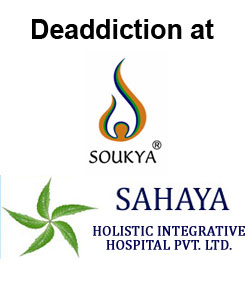ADDICTION
Addiction is a persistent, compulsive dependence on a behavior or substance. The term has been partially replaced by the word dependence for substance abuse. Addiction has been extended, however, to include mood-altering behaviors or activities. There are mainly two types of addictions: substance addictions (for example, alcoholism, drug abuse, and smoking); and process addictions (for example, gambling, spending, shopping, eating, and sexual activity).
Some defining characteristics of addiction include impaired control over the substance/behavior, preoccupation with the substance/behavior, continued use despite consequences, and denial.
Addiction can also be viewed as a continued involvement with a substance or activity despite the negative consequences associated with it. Pleasure, enjoyment or relief from actual or perceived ailments would have originally been sought; however, over a period of time involvement with the substance or activity is needed to feel normal.
The Tenth Revision of the International Classification of Diseases and Health Problems (ICD-10) defines the dependence syndrome as being a cluster of physiological, behavioural, and cognitive phenomena in which the use of a substance or a class of substances takes on a much higher priority for a given individual than other behaviours that once had greater value. A central descriptive characteristic of the dependence syndrome is the desire (often strong, sometimes overpowering) to take the psychoactive drugs (which may or not have been medically prescribed), alcohol, or tobacco. There may be evidence that return to substance use after a period of abstinence leads to a more rapid reappearance of other features of the syndrome than occurs with nondependent individuals.
In 1964 a WHO Expert Committee introduced the term ‘dependence’ to replace the terms ‘addiction’ and ‘habituation’. The term can be used generally with reference to the whole range of psychoactive drugs, Drug dependence, chemical dependence, substance use dependence, or with specific reference to a particular drug or class of drugs (e.g. alcohol dependence, opioid dependence). While ICD-10 describes dependence in terms applicable across drug classes, there are differences in the characteristic dependence symptoms for different drugs.
Behavioral addictions are patterns of behavior, which follow a cycle similar to that of substance dependence.
This begins with the individual experiencing pleasure in association with a behavior and seeking that behavior out, initially as a way of enhancing their experience of life, and later, as a way of coping with stress. The process of seeking out and engaging in the behavior becomes more frequent and ritualized, until it becomes a significant part of the person's daily life. When the person is addicted, they experience urges or cravings to engage in the behavior, which intensify until the person carries out the behavior again, usually feeling relief and elation.
Causes and symptoms
Addiction to substances results from the interaction of several factors:
Drug chemistry
Some substances are more addictive than others, either because they produce a rapid and intense change in mood; or because they produce painful withdrawal symptoms when stopped suddenly.
Genetic factor
Some people appear to be more vulnerable to addiction because their body chemistry increases their sensitivity to drugs. Some forms of substance abuse and dependence seem to run in families; and this may be the result of a genetic predisposition, environmental influences, or a combination of both.
Brain structure and function
Using drugs repeatedly over time changes brain structure and function in fundamental and long-lasting ways. Addiction comes about through an array of changes in the brain and the strengthening of new memory connections. Evidence suggests that those long-lasting brain changes are responsible for the distortions of cognitive and emotional functioning that characterize addicts, particularly the compulsion to use drugs. Although the causes of addiction remain the subject of ongoing debate and research, many experts now consider addiction to be a brain disease: a condition caused by persistent changes in brain structure and function. However, having this brain disease does not absolve the addict of responsibility for his or her behavior, but it does explain why many addicts cannot stop using drugs by sheer force of will alone.
The anterior cingulated cortex in the frontal lobe of the brain is the area responsible for long-term craving in addicts.
Social learning
Social learning is considered the most important single factor in addiction. It includes patterns of use in the addict's family or subculture, peer pressure, and advertising or media influence.
Availability
Inexpensive or readily available tobacco, alcohol, or drugs produce marked increases in rates of addiction.
Diagnosis
In addition to a preoccupation with using and acquiring the abused substance, the diagnosis of addiction is based on five criteria:
- loss of willpower
- harmful consequences
- unmanageable lifestyle
- tolerance or escalation of use
- withdrawal symptoms upon quitting
According to the DSM-IV criteria for alcohol dependence, at least three out of seven of the following criteria must be manifest during a 12 month period:
- Tolerance
- Withdrawal symptoms or clinically defined Alcohol Withdrawal Syndrome
- Use in larger amounts or for longer periods than intended
- Persistent desire or unsuccessful efforts to cut down on alcohol use
- Time is spent obtaining alcohol or recovering from effects
- Social, occupational and recreational pursuits are given up or reduced because of alcohol use
- Use is continued despite knowledge of alcohol-related harm (physical or psychological).
Treatment
Treatment requires both medical and social approaches. Substance addicts may need hospital treatment to manage withdrawal symptoms. Individual or group psychotherapy is also helpful.
Prognosis
The prognosis for recovery from any addiction depends on the substance or process, the individual's circumstances, and underlying personality structure. Poly-drug users have the worst prognosis for recovery.
Prevention
The most effective form of prevention appears to be a stable family that models responsible attitudes toward mood-altering substances and behaviors. Prevention education programs are also widely used to inform the public of the harmfulness of substance abuse.
